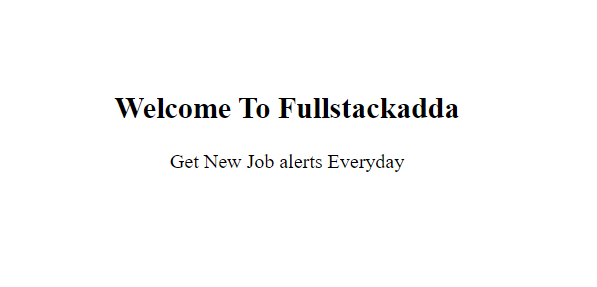HTML elements contains starting tag content and closing tag, where the element name is preceded by a forward slash as shown below with few tags −
i) Opening tag: It is used to tell the browser where the content material starts.
ii) Closing tag: It is used to tell the browser where the content material ends.
iii) Content: It is the actual content material inside the opening and closing tag.
| Start Tag | Content | End Tag |
|---|---|---|
| <p> | This is paragraph content. | </p> |
| <h1> | This is heading content. | </h1> |
| <div> | This is division content. | </div> |
EXAMPLE: In the below example <p> is a starting tag, </p> is an ending tag and it contains some content between the tags, which form an element.
<!DOCTYPE html>
<html>
<head>
<title>HTML Elements</title>
</head>
<body>
<h2>Welcome To Fullstackadda</h2>
<p>Hello</p>
</body>
</html>Output:

There are two types of HTML elements:
Block-level elements: HTML Elements
- These elements take up the full width of their parent container and create a new line after them.
<div>: This element is used to create a container for other elements, and it can be used to group related elements together. For example,<div id="header">can be used to create a container for the header section of a web page.<h1>to<h6>: These elements are used to create headings, with<h1>being the highest level heading and<h6>being the lowest. For example,<h1>Welcome to My Website</h1>can be used to create a main heading for a web page.<p>: This element is used to create a paragraph of text. For example,<p>This is my first paragraph of text.</p><ul>and<ol>: These elements are used to create unordered and ordered lists, respectively. For example,<ul><li>item 1</li><li>item 2</li></ul>can be used to create an unordered list.<blockquote>: This element is used to create a section that is quoted from another source. For example,<blockquote>Life is too short to waste time on things that don't matter</blockquote>
Here is an example of HTML code for a block element:
<div>
<h1>Welcome to My Website</h1>
<p>This is a sample paragraph.</p>
</div>
Inline elements:
- These elements take up only as much width as necessary and do not create a new line after them. Examples include
<span>,<a>,<img>and<em>. <a>: This element is used to create hyperlinks that allow users to navigate between web pages. For example,<a href="https://www.example.com">Visit my website</a><img>: This element is used to embed images in a web page. For example,<img src="image.jpg" alt="image description"><span>: This element is used to group a small part of the text to apply the css styles or javascript. For example,<p>This is my <span class="highlight">first</span> paragraph of text.</p><em>and<strong>: These elements are used to emphasize or give importance to some text. For example,<p>This is my <em>important</em> message</p><br>: This element is used to insert a line break in the text. For example,<p>This is the first line<br> This is the second line.</p>
Here is an example of HTML code for an inline element:
<p>This is a <span>sample</span> sentence.</p>
CLICK HERE to learn more about Block/Inline elements

- HTML elements contains starting tag content and closing tag.
- Block level elements take up the full width of their parent container and create a new line after them
- Inline elements take up only as much width as necessary and do not create a new line after them.
